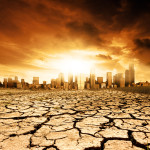The news just keeps coming: 21 04 was hot, setting a new record in the period of instrumental data, but 2015 blew right past it, shattering the previous high mark. 2016 is on track to intimidate both 2014 and 2015.
04 was hot, setting a new record in the period of instrumental data, but 2015 blew right past it, shattering the previous high mark. 2016 is on track to intimidate both 2014 and 2015.
Thanks to El Niño, errant tornadoes have raked Texas, Florida and Virginia, snow smothered parts of the East, and floods drowned towns in the South. Monster 50-foot waves in Hawaii provided kick-ass surfing opportunities for those crazy enough to risk freefalls of 30 feet into bone-crushing surf.
Perhaps Gaia (the self-regulating, life-system of Planet Earth), is trying to get our attention. It seems she has a fever. So what’s the purpose of a fever? Fever is a protective mechanism. Raise the body temperature sufficiently to enable healing by disabling or killing off hostile bacteria, viruses, and other unwelcomed biological interlopers. Ideally, the temperature is increased enough to rid the body of the offensive agents but not so high as to fatally endanger the host.
So scale up from body to planetary and what have we got? Planet Earth or Gaia senses her highly complex and multi-billion-year-old web of life is now seriously threatened by a single species – Homo sapiens. Then what’s Gaia gotta do in such a situation? Defend herself by using a proven natural response — fever.
Those who study the rapid escalation of Earth’s body temperature have termed the phenomena “global warming.” And they’ve accurately identified the root causes – combustion of fossil fuels, deforestation, release of methane by industrial plant and animal agriculture and the rapid melting of permafrost—all of which add gases into the air that cause excessive heat to be retained in the atmosphere.
But there are those who refuse to acknowledge the obvious — that Gaia’s fever is a perfectly natural and expected response to short-sighted, human activity, which is clearly lethal to the planetary fabric of life. How then will we respond — if humans are the disease and climate change and global warming is the “cure?”
“Humans do have an amazing capacity for believing what they choose and excluding that which is painful.” — Leonard Nimoy